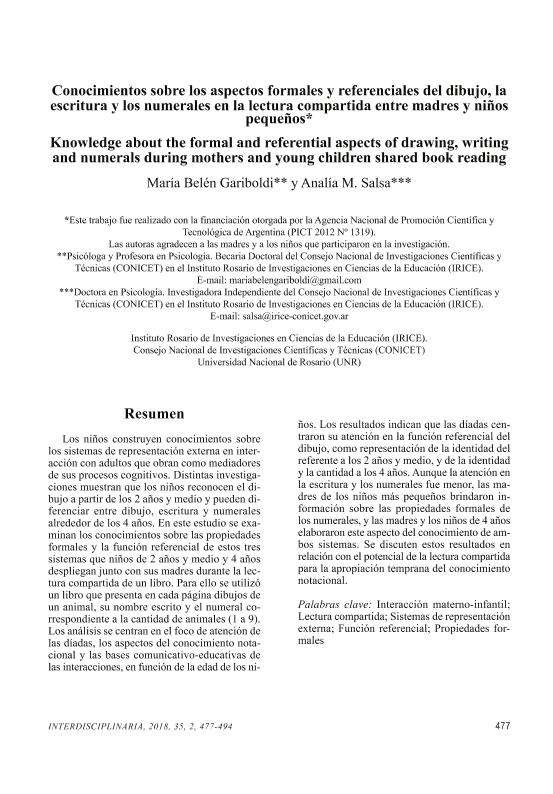Artículo
Los niños construyen conocimientos sobre los sistemas de representación externa en interacción con adultos que obran como mediadores de sus procesos cognitivos. Distintas investigaciones muestran que los niños reconocen el dibujo a partir de los 2 años y medio y pueden diferenciar entre dibujo, escritura y numerales alrededor de los 4 años. En este estudio examinamos los conocimientos sobre las propiedades formales y la función referencial de estos tres sistemas que niños de 2 años y medio y 4 años despliegan junto con sus madres durante la lectura compartida de un libro. Para ello empleamos un libro que presenta en cada página dibujos de un animal, su nombre escrito y el numeral correspondiente a la cantidad de animales (1 a 9). Los análisis se centran en el foco de atención de las díadas, los aspectos del conocimiento notacional y las bases comunicativo-educativas de las interacciones, en función de la edad de los niños. Los resultados indican que las díadas centraron su atención en la función referencial del dibujo, como representación de la identidad del referente a los 2 años y medio y de la identidad y la cantidad a los 4 años. Aunque la atención en la escritura y los numerales fue menor, las madres de los niños más pequeños brindaron información sobre las propiedades formales de los numerales y las madres y los niños de 4 años elaboraron este aspecto del conocimiento de ambos sistemas. Discutimos estos resultados en relación con el potencial de la lectura compartida para la apropiación temprana del conocimiento notacional. Children acquire knowledge about external representational systems in interaction with adults who operate as mediators of their cognitive processes. Several studies have shown that 2.5-year-old children are able to recognize drawings, and 4-year-old children can distinguish between drawing, writing and numerals. The present study focuses on a developmental analysis of the knowledge about the formal properties and the referential function of these three systems that 2.5- and 4-year-old children unfold with their mothers during shared reading sessions. The referential function is the representational relation between the system and the referent. Each system has a referential function that is the result of a social convention: figurative drawing depicts the identity and characteristics of the referent, writing is a graphic representation of oral language and numerals represent numerical information. The formal properties include the name of the representational systems and their graphic units, the form of the strokes, their spatial disposition and their compositional rules. Our specific goals were: (1) to establish which representational system is the main focus of attention; (2) to describe and analyze whether and how mothers and children elaborate knowledge about the formal properties and referential function of the systems; (3) to understand how notational knowledge emerges describing the educative-communicative basis of the interactions; and (4) to compare the focus of attention, notational knowledge and the educative-communicative basis of interactions as a function of children’s age. Twenty-six mothers and their 2.5- (n = 13) and 4-year-old children (n = 13) participated. They were given a book and told to look at it together. The book was specially designed for this study; it includes in each page drawings of an animal, its written name and the numeral for the number of animals depicted (1 to 9). We designed a system of categories with three levels of analysis, related to the specific goals of the study: focus of attention, notational knowledge and educative-communicative basis. We performed non-parametric statistical analysis: Wilcoxon test and MannWhitney’s U test. Results show that dyads of both age groups focused their attention on drawings more than on writing and numerals. However, 4-year-old children and their mothers made significantly more utterances about writing and numerals than the other group. Attention to writing and numerals in the older group seemed to be guided by mothers’ interest to teach those systems to their children. Dyads talked especially about the referential function of drawing, as a representation of the identity of the referent at 2.5 years of age and as a representation of the identity and quantity at 4 years. Although less attention was paid to writing and numerals, the youngest children’s mothers provided information about the formal properties of numerals and the mothers and the 4-year-old children elaborated this aspect of knowledge of both representational systems. Furthermore, in the older group, dyads started to discuss the referential function of numerals. With regard to the educative-communicative basis of the interactions, the mothers of both age groups tended to request information about the referents of drawings more than to provide their children with this kind of information. The mothers in the 2.5-year-olds’ group provided information about the formal properties of numerals, while in the 4-year-olds’ group the mothers both requested and provided this kind of information. Finally, the formal properties of writing were elaborated only by mothers in the older group. We discuss these results in terms of the potential of shared reading for the early acquisition of notational knowledge.
Conocimientos sobre los aspectos formales y referenciales del dibujo, la escritura y los numerales en la lectura compartida entre madres y niños pequeños
Título:
Knowledge about the formal and referential aspects of drawing, writing and numerals during mothers and young children shared book reading
Fecha de publicación:
11/2018
Editorial:
Centro Interamericano de Investigaciones Psicológicas y Ciencias Afines
Revista:
Interdisciplinaria
ISSN:
1668-7027
Idioma:
Español
Tipo de recurso:
Artículo publicado
Clasificación temática:
Resumen
Archivos asociados
Licencia
Identificadores
Colecciones
Articulos(IRICE)
Articulos de INST.ROSARIO DE INVEST.EN CS.DE LA EDUC. (I)
Articulos de INST.ROSARIO DE INVEST.EN CS.DE LA EDUC. (I)
Citación
Gariboldi, María Belén; Salsa, Analía Marcela; Conocimientos sobre los aspectos formales y referenciales del dibujo, la escritura y los numerales en la lectura compartida entre madres y niños pequeños; Centro Interamericano de Investigaciones Psicológicas y Ciencias Afines; Interdisciplinaria; 35; 2; 11-2018; 477-494
Compartir




